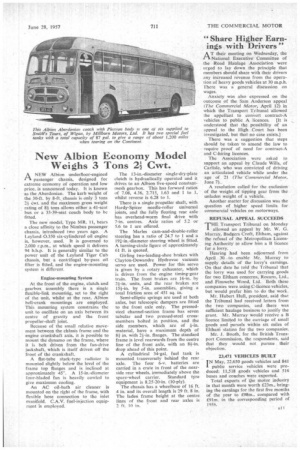New Albion Economy Model Weighs 3 Tons 2; Cwt.
Page 45

If you've noticed an error in this article please click here to report it so we can fix it.
A NEW Albion underfloor-engined
passenger chassis, designed for extreme economy of operation and low price, is announced today. It is known as the Aberdonian. The kerb weight of the 30-ft. by 8-ft.. chassis is only 3 tons 21 cwt and the maximum gross weight rating of 8+ tons allows either a 41-seat bus or a 35-39-seat coach body to be fitted.
The new model, Type MR. 11, bears a close affinity to the Nimbus passenger chassis, introduced two years ago. A Leyland .0.350 six-cylindered oil engine is, however, used It is governed to 2,000 r.p.m., at which speed it delivers 94 b.h.p. It is generally similar to the power unit of the Leyland Tiger Cub chassis, but a centrifugal by-pass oil filter is fitted, and the engine-mounting system is different.
Engine-mounting System At the front of the engine, clutch, and gearbox assembly there is a single flexible-link mounting, set to the right of the unit, whilst at the rear, Albion bell-crank mountings are employed. This mounting system constrains the unit to oscillate on an axis between its centre of gravity and the front propeller-shaft joint.
Because of the small relative movement between the chassis frame and the engine crankshaft axis, it is possible to mount the dynamo on the frame, where it is belt driven from the fan-drive jack shaft, which is itself driven off the front of the crankshaft.
A flat-tube stack-type radiator is mounted slightly below the level of the frame top flanges and is inclined at approximately 45°. A 15-in.-diameter four-bladed fan is heavily cowled to give maximum cooling.
An AC oil-bath air cleaner is mounted on the right of the frame, with flexible hose connection to the inlet manifold. C.A.V. fuel-injection equipment is employed. The 13-in.-diameter single-dry-plate clutch is hydraulically operated and it drives to an Albion five-speed constantmesh gearbox. This has forward ratios of 7.08, 4.36, 2.715, 1.63 and 1 to 1, whilst reverse is 6.28 to 1.
There is a single propeller shaft, with Hardy-Spicer needle-roller universal joints, and the fully floating rear axle has overhead-worm final drive with 7-in. centres. Axle ratios of 5.2 or 5.6 to 1 are offered.
The Marks cam-and-double-roller steering has a ratio of 24.7 to 1 and a 191-in.-diameter steering wheel is fitted. A turning-circle figure of approximately 61 ft. is quoted.
Girling two-leading-shoe brakes with Clayton-Dewandre Hydrovac vacuum servo are used. Power for this servo is given by a rotary exhauster, which is driven from the engine timing-gear train. The front brakes are 16-in. by 21-in, units, and the rear brakes arc 151-in. by 5-in, assemblies, giving a total friction area of 451 sq. in.
Semi-elliptic springs are used at both axles, but telescopic dampers are fitted to the front axle only. The pressedsteel channel-section frame has seven tubular and two pressed-steel crossmembers bolted in position, and the side members, which are of Fin. material, have a maximum depth of 81 in. with 21-in. flanges. The standard frame is level rearwards from the centre line of the front axle, with an 84--in. drop ahead of this point.
A cylindrical 34-gal, fuel tank is mounted transversely behind the rear axle. The four 6-v. batteries are carried in a crate in front of the nearside rear wheels, immediately above the spare-wheel carrier, Standard tyre equipment is 8.25-20-in. (10-ply).
The chassis has a wheelbase of 16 ft. 4 in. and its overall length is 29 ft. 8 in. The laden frame height at the centre lines of the front and rear axles is 2 ft. 10 in.








































































































































